Gunwharf Quays
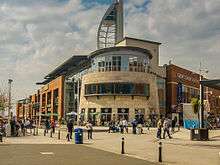 The East Plaza at Gunwharf Quays | |
| Location | Portsmouth, Hampshire, England |
|---|---|
| Owner | Land Securities |
| No. of stores and services | 93 plus a cinema, 25 bars and restaurants |
| No. of floors | 2 |
| Website | www.gunwharf-quays.com |
Gunwharf Quays is an outlet retail destination with 90 outlet stores and 30 restaurants, bars and cafés located in Portsmouth, UK. It was constructed in the early 21st century on the site of what had once been HM Gunwharf, Portsmouth. This was one of several such facilities which were established around Britain and the Empire by the Board of Ordnance, where cannons, ammunition and other armaments were stored, repaired and serviced ready for use on land or at sea. Later known as HMS Vernon, the military site closed in 1995, and opened to the public as Gunwharf Quays after six years of reconstruction (which included the restoration of some of the surviving 18th and 19th-century Gun Wharf buildings). The landmark Spinnaker Tower, which also stands on the site, was opened a few years later.
History
The site
Before the Gun Wharf was built the area was nothing more than marshy ground lying below the waterline. The main feature on this particular stretch of shoreline was the sizeable Mill Pond, which served to power a pair of tide mills on the waterfront. (When the Gun Wharf expanded in the 1770s, the Ordnance Board purchased these mills and consolidated them into a single establishment known as the King's Mill; it went on to produce flour for the military until 1868 when it was destroyed by fire.)
The Gun Wharf
An Ordnance Yard (Gun Wharf) began to be established on the present site in the late 17th century (replacing an earlier Wharf on the Point). Built to serve the ordnance needs of the Fleet, the Dockyard and the town fortifications, it was constructed on reclaimed marshland between Old Portsmouth and Portsea, just north of the body of water known as the Mill Pond (a vestige of which survives today as the Canal within Gunwharf Quays). In the 1770s a decision was taken to extend the Yard to the south, so further land was reclaimed, extending the Yard and doubling its size. The original Yard and its extension (known respectively as "Old Gun Wharf" and "New Gun Wharf") functioned as two halves of a single operation. They were linked, by way of a swing bridge, across a short Canal, which guaranteed a flow of water in and out of the Mill Pond; it later formed the entrance to a triangular Basin where loading and unloading of vessels could take place.
Function
Prior to 1855, a ship's guns (as well as its other weapons: small arms, cutlasses etc.) belonged not to the Admiralty or the Navy Board, but to the Board of Ordnance, whose Ordnance Yards were constructed alongside, but independent from, the Royal Dockyards. These Yards were repositories providing armament and ammunition not only for ships but also for land defences, and for transport overseas when required. Furthermore, in the days of sail warships required periodic checking and maintenance (and often repair after a naval battle). This often necessitated the ship being placed into a dry dock; however, a ship could not be placed in dry dock with its guns on board as the weight would severely damage the wooden structure once the support of the sea water was lost and the keel took all the weight of the ship and its contents. The ship would therefore offload all of its guns at one of the Gunwharf Quays before being dry docked.
Operation

Most of the area of the 19th-century Gun Wharf, and the majority of its buildings, was given over to storage. On the New Gun Wharf, the prominent Grand Storehouse (later known as Vulcan) was designated as a "Land Service Store"; it was mirrored by a similarly sizeable "Sea Service Store" on the Old Gun Wharf (later remodelled to serve as the Warrior naval accommodation block). In addition to these two, a plan dated 1859 indicates more than a dozen other large storehouses all around the site.[1] Alongside the storehouses were a range of workshops: for blacksmiths, carpenters, coopers, specialist armourers and others.
A wide range of ordnance-related equipment had to be accommodated within the Yard. Gun carriages in particular took up a lot of space, and were prone to decay if left outside. Cannons and cannonballs, on the other hand, could be stored in the open air without too much damage being done, as described here in 1817:
Every ship in ordinary has on the wharf her guns, placed in regular rows, each ship's guns by themselves, with the name of the ship they belong to, painted in capital letters on the first gun of each parcel. The balls are formed in pyramids from 42 pounders to the lowest bores, every size in a pyramid by themselves; the bomb shells are also placed in the same regular order.[2]
As at other Ordnance Yards, the official with oversight of the operation was (appropriately enough) called the Storekeeper; he was initially accommodated in one of a row of large houses on the north-east edge of the site, alongside other ordnance board officials (the Clerk of the Cheque, the Clerk of the Survey and other senior Clerks) who were responsible for the recipt, issue and safe maintenance of the Gun Wharf's valuable assets.
One item that was not stored at the Gun Wharf was gunpowder, which was kept in the Square Tower (initially) and then in magazines at Priddy's Hard from 1777.
Gunwharf Barracks
In 1824 a set of storehouses along the southern edge of the site were converted to form barracks for the Royal Marine Artillery (the first time that this section of the Corps had been provided with its own separate barracks). A wall was built, within the perimeter, which separated the barracks from the rest of the Gunwharf. In 1858 the RMA moved out (first to Fort Cumberland, then to the new purpose-built Eastney Barracks); the Gunwharf Barracks then began to be occupied by Artillery and other troops until 1888 when they reverted to use as storehouses.
After 1855
After the demise of the Ordnance Board in 1855 the War Office took over responsibility for the Gun Wharves. This arrangement left the Navy at a perceived disadvantage; a series of reviews ended in 1888 with oversight of Ordnance Yards divided, some going to the Army, some to the Navy and some (like Portsmouth's) split between the two (the Army taking the Old Gun Wharf and the Navy the New Gun Wharf). During the First World War, however, the entire site was taken over by the Navy, and it remained in Navy hands thereafter until its closure in 1995.
HMS Vernon
As ships and armaments developed, the requirement to offload the armament diminished, and the Gunwharf fell into disuse. The site was re-established as the Royal Navy shore establishment HMS Vernon in 1923.
Closure and redevelopment
Following several naval restructures and mergers, HMS Vernon ceased to be an independent command and was renamed HMS Nelson (Vernon site) on 31 March 1986. In 1987 it was renamed again to HMS Nelson (GunWharf) although locally it continued to be known as HMS Vernon. Following many more reorganisations and mergers, all of HMS Nelson (Gunwharf)'s operations were deployed elsewhere, and it ceased operations in 1995. The site was subsequently sold for redevelopment.
Present day
The development opened as Gunwharf Quays on 28 February 2001. The concept for the redevelopment was by the local firm HGP Architects.
About
Gunwharf Quays plays host to a 14-screen Vue cinema, 26-lane Bowlplex Bowling Alley, Aspex art gallery, Grovenor casino, a Holiday Inn Express and a Tiger Tiger nightclub. The waterfront overlooks Gunwharf Quays Marina which can accommodate all types of craft including luxury yachts up to 80 metres and has often played host to national and international sailing events. The Berkeley Group plc was responsible for the development of Gunwharf Quays, which is now owned by Land Securities. The area has also become a residential area of Portsmouth, and houses many apartment buildings. In 2012, the penthouse at no 1 Gunwharf Quays was on sale for £2.5 million
Retained historic buildings and structures
HMS Vernon suffered extensive damage during the Blitz, but a number of historic structures survived, some of which have been restored as part of the Gunwharf Quays development.
- The Old Customs House pub and restaurant, built as an administration block in the late 18th century, is the oldest building on the site and the only significant survival on the Old Gun Wharf side.[3]
- An early 19th-century gateway stands behind the Vulcan building, indicating the line of the original boundary of the New Gun Wharf;[4] Initially hemmed in by the fortifications of Old Portsmouth, the site expanded further when the town fortifications were levelled in the 1870s; much of the later perimeter wall, which dates from this expansion, remains in place around the edge of the site, along with the Main Gate of c.1870.[5]
- The Grand Storehouse (later called the Vulcan Building) was the principal structure on the New Gun Wharf, built 1811-14. Its north wing and clock tower were both destroyed in the Blitz and only reinstated as part of the Gunwharf Quays reconstruction.[6]
- The old Royal Marine Infirmary building was originally built as an Ordnance Storehouse at around the same time as the Vulcan block; together with other nearby storehouses it was converted to form Gunwharf Barracks, of which it is the only surviving part.[7]
- Behind the Vulcan building, and dwarfed by it, is a former shell store (Building No. 25) dating from 1856.
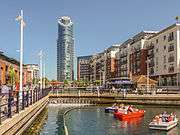 Canalside looking towards the Plaza. The small roofed building right of centre was a guardhouse for the bridge which linked the two halves of the site.
Canalside looking towards the Plaza. The small roofed building right of centre was a guardhouse for the bridge which linked the two halves of the site. Ordnance Yard administration block (1770s)
Ordnance Yard administration block (1770s) Former Ordnance Storehouse (aka Vulcan building) (1811)
Former Ordnance Storehouse (aka Vulcan building) (1811)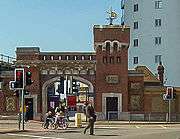 Former gatehouse and perimeter wall (1870s)
Former gatehouse and perimeter wall (1870s).jpg) Lodge and guardhouse inside the Main Gate
Lodge and guardhouse inside the Main Gate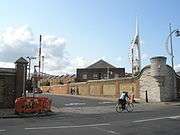 Former Royal Marine Infirmary (c.1814) within the perimeter wall
Former Royal Marine Infirmary (c.1814) within the perimeter wall- Quayside crane
 Preserved figurehead from HMS Marlborough, which latterly served as an accommodation hulk for HMS Vernon.
Preserved figurehead from HMS Marlborough, which latterly served as an accommodation hulk for HMS Vernon.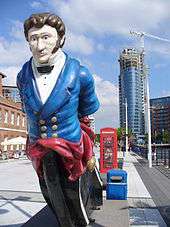 Figurehead from the original (1832) ship HMS Vernon.
Figurehead from the original (1832) ship HMS Vernon.
See also
References
- ↑ "Plan of Gunwharf 1859". Minewarfare & Clearance Diving Officers' Association.
- ↑ Allen, Lake (1817). The History of Portsmouth. London: Hatfield & co.
- ↑ "Listed building description".
- ↑ "Listing text".
- ↑ "Listing text".
- ↑ "Listed building text".
- ↑ "Listed building description".
External links
| Wikimedia Commons has media related to Gunwharf Quays. |
Coordinates: 50°47′42″N 1°06′21″W / 50.7949°N 1.1058°W